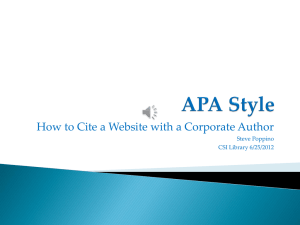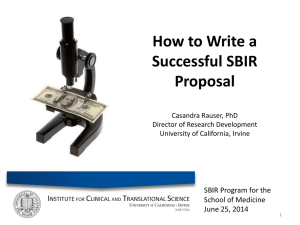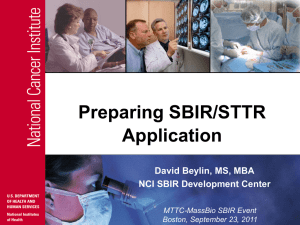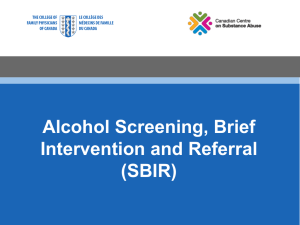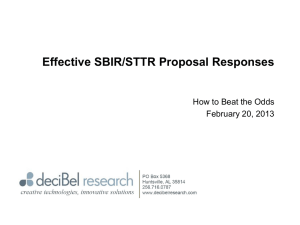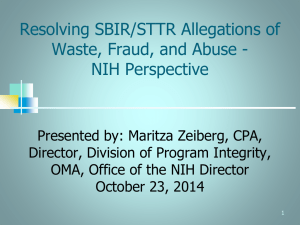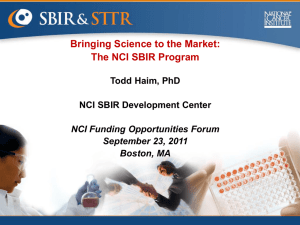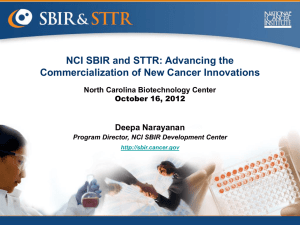SBIR R&D Contract Opportunities at NIH
advertisement
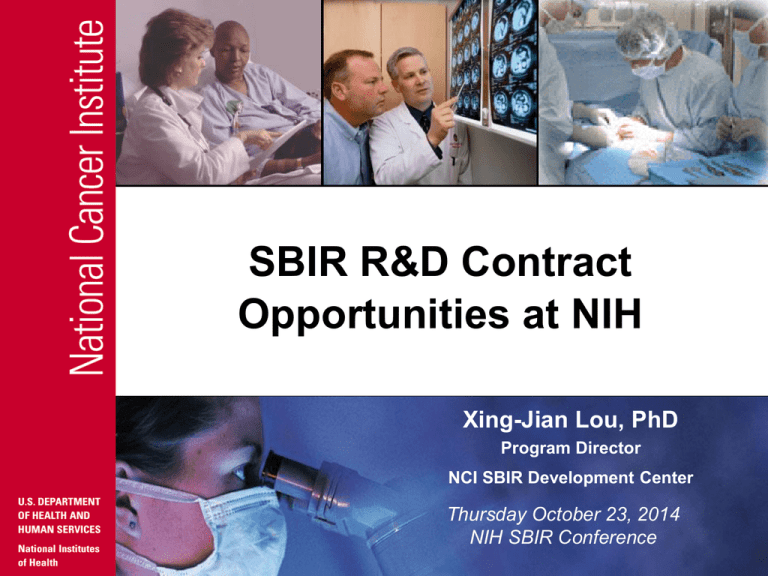
SBIR R&D Contract Opportunities at NIH Xing-Jian Lou, PhD Program Director NCI SBIR Development Center Thursday October 23, 2014 NIH SBIR Conference Today’s Presentation 1. Why Does NIH Use SBIR Contracts? 2. How Contract Topics Get Chosen 3. Different between Contracts and Grants 4. The Proposal, Review and Funding Process 5. Contract Topic Example 6. Questions Why Does NIH Use SBIR Contracts? SBIR contracts allow an institute to direct companies to develop products in areas of high priority (usually narrow technical focus) Institute-run ad hoc peer review panels where there is balanced representation of business versus technical reviewers Program staff are very involved in funding decisions o Deliverables negotiated by program staff in advance of awardonce in the contract, these are “must do” items o Quantitative milestones Program staff (project officer/contracting officer’s representative) are also very involved in management of funded projects NCI SBIR/STTR Award Budget Distribution Administrative Supplements NIH Technical Assistance Programs Contracts Grants NCI SBIR Targeted Contract Solicitations Areas of interest to the commercial sector, based on market opportunity NCI scientific & technology priorities Contract topics in NCI priority areas with strong potential for commercial success $37,406 $25,020 13% 2007 25% $7,757 13% 17% 8% 2008 2009 NCI SBIR contracts (thousands) $26,102 $16,665 $12,387 $38,174 24% 17% 33% 35% 25% 2012 2013 8% 2010 2011 Fiscal Year % of total NCI SBIR How Contract Topics Get Chosen? Jan Feb Apr Jun Aug Development of SBIR Contract Topics Call for Contract topics Concept Development Submit the Topics TAG Review SPL Approval Publish the Contract Topics Trans-NCI Technology Advisory Group (TAG), with membership from all Divisions and offices whose missions overlap with SBIR TAG Committee reviews, discusses, and scores solicitation proposals (contracts, grants, and cooperative agreements) SBIR office prepares package for NCI Scientific Program Leaders Committee (Executive Committee) 10-25 NCI SBIR contract topics are approved for publication in Omnibus NIH SBIR Contract RFP published in August Different between Contracts and Grants Scope of the proposal Set-aside of funds for particular areas? Funding Solicitations for SBIR Grants Funding Solicitation for SBIR Contracts Investigator-defined within the mission of NIH Defined by the NIH (focused) NO YES Questions during solicitation period? May speak with any Program Officer MUST contact the contracting officer Receipt Dates 3 times/year for Omnibus Only ONCE per year Basis for Award Based on score during peer review If proposal scores well during peer review, must then negotiate to finalize deliverables with NIH Reporting One final report (Phase I); Annual reports (Phase II) Monthly or quarterly progress reports The decision point is whether the contract topic is a true fit for your project NIH SBIR Contracts Request For Proposals (RFP) Both for NIH & CDC Issued once a year o Released late summer o Proposals usually due in early November Includes: o Proposal preparation instructions o Page Limits – All inclusive -50 for Phase I; 150 for Phase II o Definitions o Evaluation Criteria o Institute Points of Contact o Research Topics o Additional Guidance (for example Human Subjects) o Forms (with links) Proposal and Funding Process (Phase I) Receive the Review Negotiation Results YES Must be received by 11/5/14, 4:30 pm ET Request a Debrief NIH SBIR RFP published in August within 3 days Decide to Apply 1. 2. Build the application Submit the application Receive the Award PO is barred from communicating with potential offerors 3. Proposals due November 4. NCI ad hoc technical review panels meet Jan-April (1- 55 proposals; end products are score 0-1,000, plus technical acceptability judgment, plus technical minutes document) 5. PO recommends competitive range in memo to CO May-June 6. Negotiations to address technical and budgetary weaknesses 7. Self-certification of SBIR eligibility (company ownership structure) 8. Award in September (1-10 contracts per topic) Proposal and Funding Process (Phase II) 1. Review Phase I final report (technical and commercial potential)- June, rolling basis 2. Invitation Letter RFP goes out to company- Nov-Feb 3. Phase II proposal (2 years, < $2M) due- Jan-April 4. Technical review meeting (usually 1-3 proposals) 5. Rest of process as for Phase I Contract Review Criteria Phase I Technical Evaluation Criteria Weight 1. The soundness and technical merit of the proposed approach based on: 40% a. Clear measureable goals (milestones) that have a reasonable chance of meeting the topic objective in Phase I; b. The approach is innovative and not routine, c. Offeror’s ability to implement technical approach 2. The qualifications of the proposed PDs/PIs 20% 3. The potential of the proposed research for technological innovation. 15% 4. The potential of the proposed research for commercial application. The commercial potential of a proposal will be assessed using the following criteria: 15% a. Whether the outcome of the proposed research activity will likely lead to a marketable product or process. b. The offeror’s discussion of the potential barriers to entry and the competitive market landscape as well as method to overcome. 5. The adequacy and suitability of the facilities and research environment 10% Contract Review Criteria For Fast-Track applications: Phase II Technical Evaluation Criteria Weight 1. The soundness and technical merit of the proposed approach based on: a. Clear measureable goals (milestones) that have a reasonable chance of meeting the topic objective in Phase II; b. The approach is innovative and not routine, c. Offeror’s ability to implement technical approach 30% 2. The potential of the proposed research for commercial application, as documented in the Commercialization Plan and evidenced by: a. Offeror’s record of successfully commercializing prior SBIR/STTR or other research projects b. Commitments of additional investment during Ph I & Ph III from private sector or other non-SBIR funding sources c. Other indicators of commercial potential for the proposed research 30% 3. The qualifications of the proposed PDs/PIs, supporting staff and consultants. 25% 4. The adequacy and suitability of the facilities and research environment 15% NCI Management of Funded SBIR Contracts Individual Program Staff First deliverable is kickoff presentation to COR by contractor- tied to an invoice (first payment of contractor) Communication with contractor unlimited Quarterly progress reports tied to invoices which COR must approve (electronic) Annual report required for Phase II (end of year 1) Commercialization plan required at end of Phase I project period and then again within Phase II proposal Final report required for both Phase I and Phase IIs Mentoring as time allows Investor Forums Phase II contract can be followed with Phase IIB Bridge grant funding Example: Development of Novel Therapeutic Agents That Target Cancer Stem Cells (Fast-Track proposals will be accepted.) Budget (total costs): PhI: $300,000 for 9 months; PhII: $2,000,000 for 2 years Number of anticipated awards: 2-3 Project Goals: Proposals under this topic should be involved the development of novel therapeutic agents that target CSCs. These small molecules or biologics should be designed to target CSCs, CSCrelated biomarkers, or CSC pathways that affect fundamental processes associated with carcinogenesis, tumor progression, maintenance, recurrence or metastasis. Particular emphasis is placed on agents that target CSC self-renewal, regeneration, or differentiation processes. Phase I Activities & Deliverables: Demonstrate in vitro efficacy for the agent(s) that targets CSCs. Validate the effect of the agent(s) on CSCs. The offerors are required to provide evidence confirming that the agent(s) specifically targets CSCs (e.g., measurement showing reduced quantity, viability, or frequency of CSCs). Conduct structure-activity relationship (SAR) studies, medicinal chemistry, and/or lead antibody optimization (as appropriate). Perform animal toxicology and pharmacology studies as appropriate for the agent(s) selected for development. Develop a detailed experimental plan (to be pursued under a future SBIR Phase II award) necessary for filing an IND or an exploratory IND. FY15 NCI Contract Funding Topics - Due Date: November 5, 2014 Therapeutics • 336 Development of Novel Therapeutic Agents that Target Cancer Stem Cells In Vitro Diagnostics • 337 Cell-Free Nucleic Acid-Based Assay Development for Cancer Diagnosis Advancing Cancer Research • 334 Vacutubes to Preserve the Viability of Circulating Tumor Cells • 335 Development of Advanced Culture Systems for Expansion of Cancer Stem Cells Medical Devices & Radiation Therapy • 338 Predictive Biomarkers of Adverse Reactions to Radiation Treatment • 339 Systemic Targeted Radionuclide Therapy For Cancer Treatment Health IT • 340 Validation of Mobile Technologies for Clinical Assessment, Monitoring, and Intervention 15 Should I apply for a contract or a grant? Do you specifically fit the goals and deliverables of the contract? Would this project be a focus of the company? Remember, you cannot submit the same project to both mechanisms Either Way, Use NIH Reporter http://projectreporter.nih.gov/reporter o Search previous funded grants and contracts o Search for potential collaborators o How does your project stack up? Ask Away… http://sbir.cancer.gov Email: ncisbir@mail.nih.gov Refer to Contact Us Page for Individual Contacts Xing-Jian, Ph.D. Program Director NCI SBIR Development Center
